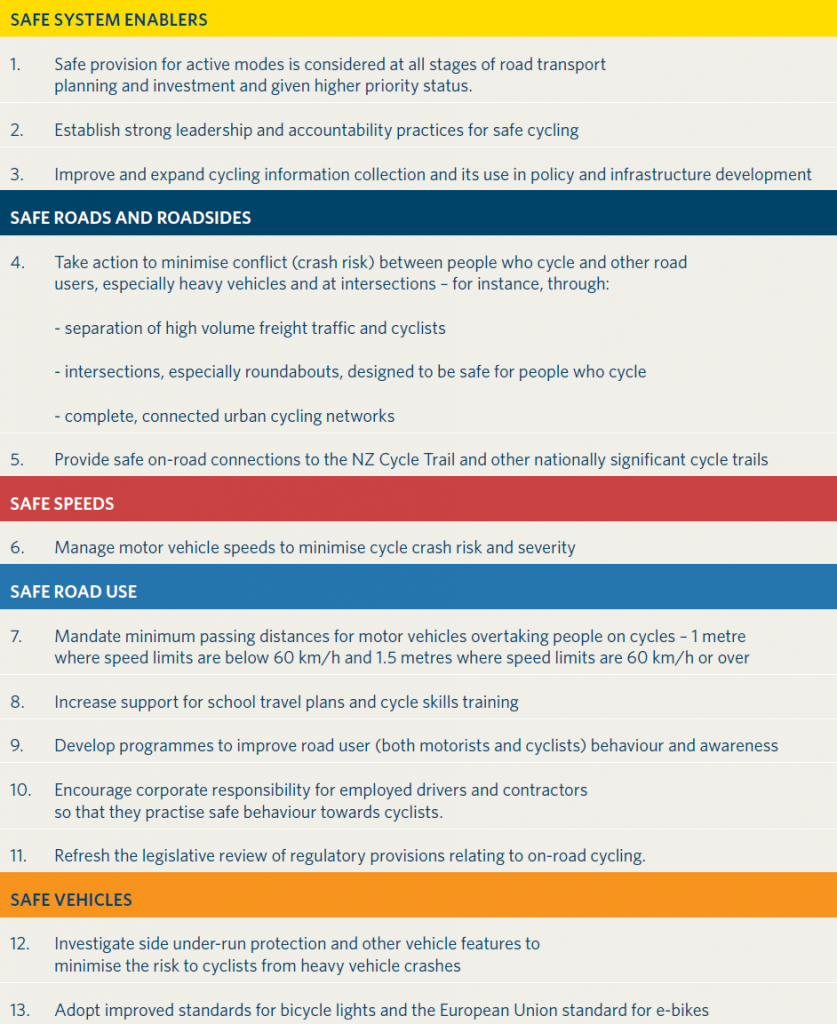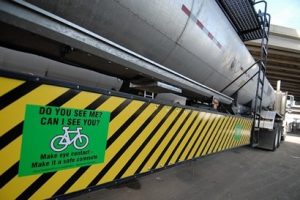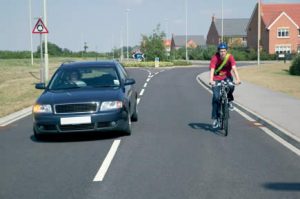It seems like a long week since the tragic events of last Monday when a cycle tourist lost his life in Hornby courtesy of a turning truck. As timing goes, it was intriguing that this was also the same week that the truck driver from April’s cycle fatality was also sentenced. And, although they were already out for two weeks, the draft recommendations from the Cycle Safety Panel poured a bit more petrol on the media bonfire.
Some time ago I told you about my new little side-distraction: being part of the National Cycle Safety Panel. That seems like an eternity ago now, what with a whole raft of multi-day meetings and piles of reading since then. Now the first fruits of that effort have been revealed in the form of the draft report and recommendations. With the recent fatality, it is pertinent to consider how the recommendations might have made a difference in this case and similar ones.

There is no silver bullet to cycle safety; even those who think it’s just about more Dutch-style infrastructure would do well to remember that nearly 200 people/year still die while cycling in The Netherlands. So the Cycle Safety Panel came up with a wide range of ideas that were based around the “Safer System” approach targeting roads, speeds, vehicles and road users. Thirteen broad recommendation areas were proposed (see below), although most of them include a number of more specific suggested actions.

One thing the Panel recognised was that the problem is arguably more about perceived safety rather than actual safety. Yes, things could always be safer, but cycling in New Zealand is already not the extreme sport that some make it out to be. However, by coming up with proposals that will encourage more people to cycle, we will also improve the situation by virtue of the “safety in numbers” phenomenon.
Another thing that was quickly identified was that most of the likely solutions to improving cycle safety are already well known – the problem is that they are not happening here. There are a myriad of reasons why that is the case, from unhelpful central/local Govt policies and practices to oversights in our legislation. So a lot of the suggestions listed above are more about “process issues”; things that might be changed by the flick of a pen or a better auditing procedure, and ultimately just more people making a commitment for things to happen. Not as sexy as cool new cycle infrastructure on the ground, but no less important.

A couple of the proposals got particular attention this week, particularly in relation to truck safety. First was the suggestion to install side under-run barriers on trucks to prevent cyclists (and pedestrians) from getting caught under passing trucks. These are mandated in Europe and common elsewhere overseas, but the local truckies aren’t convinced about the merits compared with the cost of fitting these. A preliminary investigation here suggested that there was some safety benefit to be had (esp. for fatal truck crashes), but more investigation of all the costs and benefits in the NZ context is needed. It may be that technological solutions like blind-spot cameras and warning sensors may be more cost-effective, although they probably wouldn’t do much about overtaking-related crashes.

Overtaking was also much in mind with the proposal to introduce a mandatory minimum passing distance when overtaking a cyclist, which is now quite common in the US. Like the recent introduction in Queensland, the suggestion is for a 1.0m gap on roads up to 60km/h and 1.5m for faster roads. Perhaps predictably there has been a flurry of complaints from people that it would be impossible to pass a cyclist in many cases with such a rule. That’s the point: if it’s not safe to overtake in the same direction, you are expected to either slow down and wait, or to overtake using the next lane over when the way is clear. Interesting how so many people jump straight to the default of trying to squeeze past between a bike and an adjacent motor vehicle – that’s how crashes happen…
There are of course a number of other initiatives proposed that would also affect the safety of truck-bike crashes. The Panel also suggested:
- Better planning to locate major freight and bike routes in different places where possible
- More use of infrastructure that provides separated bikeways and separate phasing at signalised intersections
- Greater use of lower-speed street environments, especially away from arterial routes
- Running more “road user workshops” to get cyclists and professional drivers to sit in each other’s seats and discuss road interaction issues
- More cycle skills training programmes for adults and schoolchildren, to improve good riding techniques and awareness of common hazards
- Greater use of programmes to make road users aware of how to interact with each other (e.g. knowledge of blind spots around heavy vehicles)
- More onus on employers to ensure that their drivers are suitably trained and vehicles suitably equipped to interact safely with people cycling
Watch out soon too for news about some cycle safety initiatives happening around Christchurch…
It’s not just trucks of course; other motorists are involved in 70% of fatal and 94% of injury cycle crashes. So many of the recommendations are also geared at tackling all of these crashes too (not to mention the even greater number of “cycle-only” crashes, such as hitting roadside objects or sliding on gravel). It it likely to take a combination of infrastructure, legislation, speed management, road user education, vehicle changes, and simply improvements in the way that we develop and maintain our road network.
The Cycle Safety Panel will be meeting with many key stakeholders (e.g. road user groups, central/local govt organisations) on Oct 17th to hear their feedback. You can also send your individual feedback to cyclingsafetypanel@nzta.govt.nz by Fri 24 October. After that the report and recommendations will be finalised and passed on to the incoming Transport Minister in November.
What do you think of the draft report and recommendations? What’s good / so-so / missing?

I still think the key thing is to build proper (safe) cycle infrastructure. It’s such a shame that this wasn’t done when many of the roads around Christchurch were being rebuilt post-earthquake.
Hopefully this unfortunate death helps to motivate those in power to address these issues. Unfortunately, New Zealand is backwards in many respects.
Looks good. Safer cycling is also about education. For the cyclist as much as for motorists. I ride a bike, motorcycle and drive a car and there are different skill sets for each. To get my motorcycle license I had to do several training courses and a big component of this was keeping safe around hazards esp cars and other vehicles (positioning yourself safely on the road, anticipating hazards). This was stuff I had been doing as a cyclist for years. How do we provide this education for the young cyclist or someone new to cycling. I know schools run a “cycling safety” course aimed at primary children but this is only a week long and maybe not long enough?
At primary school in the 1960’s safety education was all about road safety, particularly about how to ride a bike and be a safe pedestrian (very little else i.e. no stranger danger stuff , bullying prevention, health and safety rules , unfortunately ) . As a teenager in the 1970’s it was all about defensive driving and road courtesy. This was a time when our road death rate per head of population and car numbers was considerably higher than now. Have we become complacent as the numbers have actually improved since then? . Those safety messages have been with me all my life, so if the panel recommendations can put a heavy emphasis on early safety education, the medium to long term effects can only be positive. I am encouraged by the comprehensiveness of this report, the recommendations that it makes and look forward to implementation.
Although maybe less sexy than new infrastructure I do think think these recommendations can make a real difference on the roads. It will come down to translating these recommendations into clear milestones so that progress can be measured. I can not believe that anybody would want object he proposal to give a cyclists 1.5 meter gap, that seems to be common sense but clearly it is not.. And did the truck lobby really say that they would worry about burned out clutches if they had to slow down for cyclists on narrow roads? That says it all does it not?
It worries me that there is little here to to improve general driving skills. Number 10 is good, but it should be extended to all motorists. In fatal cycle accidents, there’s a fairly consistent rate of 70-80% of them being the fault of the motorist. It always annoys me that in spite, of this there always seems to be call for better education on BOTH sides, when it appears to me that that it’s the motorists that need educating much, much more than cyclists.
I’d suggest that numbers 7,9, and 11 could all contribute to improved driver behaviour, either directly or through greater awareness of the issues raised. For example, the suggested 1.0-1.5m metre passing rule is generating all sorts of discussion about its practicality, but it’s also an opportunity to point out that sometimes it’s not appropriate to pass straight away.
Both sides equally need educating. That’s the major fix if the educated people then respect each other & obey the rules. Peace on earth ? LOL. From what I see on my daily commutes (cycle commuted 10+yrs averaging 19 weekdays per month) , purely based on numbers, a higher proportion of cyclists disobey basic road rules than drivers. So cyclists need more enforcing than drivers do as seems risk isn’t something that controls rider behaviour? The risk to Chch cyclists is particularly high at moment but seems high consequence is not being thought about by the non law abiding riders. Cyclist behaviour appears to be worse than a few years ago.